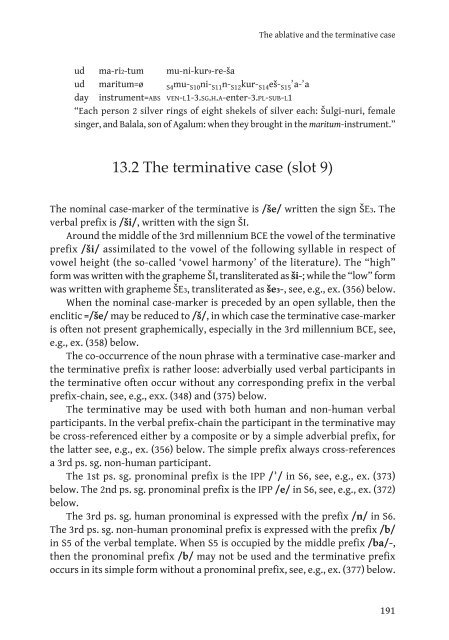SUMERIAN
Zolyomi_Sumer_READER
Zolyomi_Sumer_READER
Create successful ePaper yourself
Turn your PDF publications into a flip-book with our unique Google optimized e-Paper software.
The ablative and the terminative case<br />
ud ma-ri₂-tum mu-ni-kur₉-re-ša<br />
ud maritum=ø S4 mu- S10 ni- S11 n- S12 kur- S14eš-S15ʾa-ʾa<br />
day instrument=ABS VEN-L1-3.SG.H.A-enter-3.PL-SUB-L1<br />
“Each person 2 silver rings of eight shekels of silver each: Šulgi-nuri, female<br />
singer, and Balala, son of Agalum: when they brought in the maritum-instrument.”<br />
13.2 The terminative case (slot 9)<br />
The nominal case-marker of the terminative is /še/ written the sign ŠE₃. The<br />
verbal prefix is /ši/, written with the sign ŠI.<br />
Around the middle of the 3rd millennium BCE the vowel of the terminative<br />
prefix /ši/ assimilated to the vowel of the following syllable in respect of<br />
vowel height (the so-called ‘vowel harmony’ of the literature). The “high”<br />
form was written with the grapheme ŠI, transliterated as ši-; while the “low” form<br />
was written with grapheme ŠE₃, transliterated as še₃-, see, e.g., ex. (356) below.<br />
When the nominal case-marker is preceded by an open syllable, then the<br />
enclitic =/še/ may be reduced to /š/, in which case the terminative case-marker<br />
is often not present graphemically, especially in the 3rd millennium BCE, see,<br />
e.g., ex. (358) below.<br />
The co-occurrence of the noun phrase with a terminative case-marker and<br />
the terminative prefix is rather loose: adverbially used verbal participants in<br />
the terminative often occur without any corresponding prefix in the verbal<br />
prefix-chain, see, e.g., exx. (348) and (375) below.<br />
The terminative may be used with both human and non-human verbal<br />
participants. In the verbal prefix-chain the participant in the terminative may<br />
be cross-referenced either by a composite or by a simple adverbial prefix, for<br />
the latter see, e.g., ex. (356) below. The simple prefix always cross-references<br />
a 3rd ps. sg. non-human participant.<br />
The 1st ps. sg. pronominal prefix is the IPP /ʾ/ in S6, see, e.g., ex. (373)<br />
below. The 2nd ps. sg. pronominal prefix is the IPP /e/ in S6, see, e.g., ex. (372)<br />
below.<br />
The 3rd ps. sg. human pronominal is expressed with the prefix /n/ in S6.<br />
The 3rd ps. sg. non-human pronominal prefix is expressed with the prefix /b/<br />
in S5 of the verbal template. When S5 is occupied by the middle prefix /ba/-,<br />
then the pronominal prefix /b/ may not be used and the terminative prefix<br />
occurs in its simple form without a pronominal prefix, see, e.g., ex. (377) below.<br />
191


